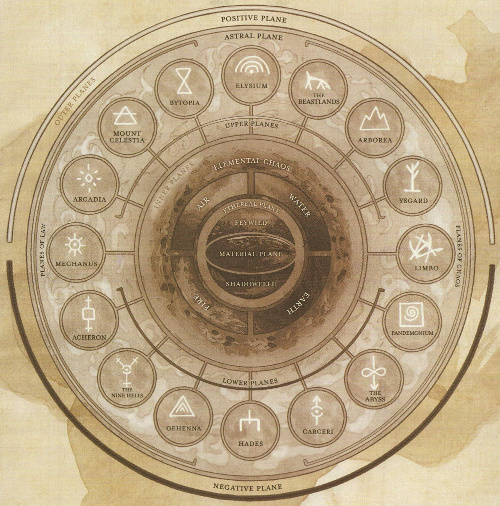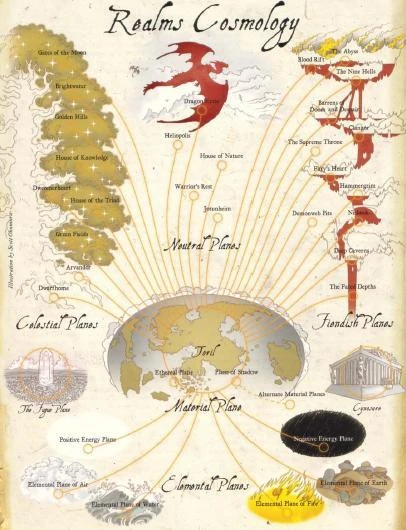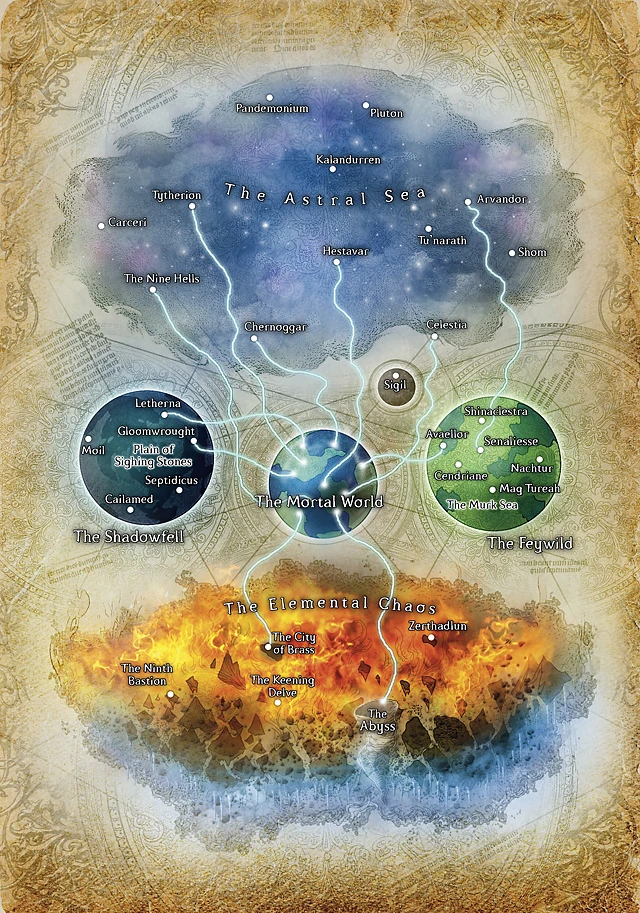Sirwhiteout (talk | contribs) (Added links to categories) |
(Adding categories) |
||
| Line 96: | Line 96: | ||
[[Category:Planes of existence]] |
[[Category:Planes of existence]] |
||
[[Category:Outer Planes]] |
[[Category:Outer Planes]] |
||
| + | [[Category:Dragon locations]] |
||
Revision as of 20:08, 18 May 2019
The Dragon Eyrie was the home of the Draconic pantheon,[3]manifesting as a vast mountain with its peak eternally covered in frost and surrounded by wispy clouds.[1]
While the Dragon Eyrie was the home of all draconic deities, only Hlal, Null, Task, and Tiamat had permanent lairs on the plane.[1]
Dragon Eyrie links
There were several "soft borders" connecting Tiamat's realm in the Dragon Eyrie with Avernus on the plane of the Nine Hells.[3][4] Dragon Eyrie also contained links to Arvandor.[3][1]
Inhabitants
Around the mountain flew the spirits of departed dragons. Other departed souls whose destination was the Dragon's Eyrie included half-dragons, dragonkin, and other forms of dragonkind. Khaasta and abishai also dwelled on this plane, and living planar dragons of all kinds visited the Eyrie from time to time. A few hermit non-dragons also inhabited the plane, although dragons only tolerated them grudgingly.[1]
Realms of the Dragon Eyrie
The mountain was divided into four major regions: the dark roots, the lower reaches, the middle crags, and the peak. With the exception of the peak, which was entirely Null's divine realm, divine realm were small regions and didn't occupied all the expanse of a given region. Most of the mountain was open territory claimed by no deity, where the petitioners of the plane sought their solitude.[1]
Hlal's realm
Hlal, trickster god and messenger deity, lived in the lower reaches with her brass dragon and copper dragon petitioners. The spirits of red dragons, blue dragons, and black dragons lived in various portions of the lower reaches as well.[1]
Null's realm
Null, god of death, ruled the entirety of the mountain's peak, along with white dragon and silver dragon petitioners attracted to the cold air and permanent snow cover.[1]
Task's realm
Task, god of greed, lived in the middle reaches in a volcanic region known as the Furnace. The spirits of red, gold, and bronze dragons lived here as well, attracted by the heat and lava.[1]
Tiamat's realm
Tiamat's realm (originally the realm of a god known as Azharul),[5] also called the Dragonspawn Pits of Azharul[4] (named by Tiamat after she killed the god),[5] was the home of the spirits of chromatic dragons who revered Tiamat above all others. Tiamat's realm existed in the depths of the plane, among the dark roots, where the spirits of shadow dragons and deep dragons also dwelt,[1] and was somehow connected to her lair in Avernus.[3]
History
The Dragon Eyrie was one of the planes destroyed by the Spellplague.[5]
Appendix
Publishing history
When they were first introduced in the 2nd edition Draconomicon[6], the realms of the various draconic deities were scattered throughout the planes: Asgorath on an unknown plane, Astilabor and Kereska on Limbo, Garyx in the Abyss, Hlal in Olympus, Lendys in Nirvana, Null in Gehenna, Tamara on Elysium, Task in Pandemonium, Xymor in the Seven Heavens, Zorquan on the Prime Material Plane, and Tiamat in the Nine Hells.
That book (which bore the Forgotten Realms label) went into great detail on the draconic afterlife, saying that a dragon's spirit (called its anima) traveled to the outer plane most appropriate to its alignment and remained there for a time equal to its mortal life. During that time, its memories and personality slowly faded, one day per day lived, in the opposite order in which the living dragon had gained them. When completely stripped bare of its worldly experiences, it was reincarnated on the mortal plane as soon as a new mortal body was available. Because the draconic population in the Realms has decreased over the millennia, however, there is a large "waiting list" of animae ready to be born. These "pure" animae resembled perfectly formed dragons of their species, and were used as messengers and servants of the draconic gods.[7]
The 3rd edition cosmology change placed all draconic deities on the same outer plane.[3]
References
- ↑ 1.00 1.01 1.02 1.03 1.04 1.05 1.06 1.07 1.08 1.09 1.10 Richard Baker, James Wyatt (March 2004). Player's Guide to Faerûn. (Wizards of the Coast), p. 150. ISBN 0-7869-3134-5.
- ↑ Richard Baker, James Wyatt (March 2004). Player's Guide to Faerûn. (Wizards of the Coast), p. 140. ISBN 0-7869-3134-5.
- ↑ 3.0 3.1 3.2 3.3 3.4 Ed Greenwood, Sean K. Reynolds, Skip Williams, Rob Heinsoo (June 2001). Forgotten Realms Campaign Setting 3rd edition. (Wizards of the Coast), p. 258. ISBN 0-7869-1836-5.
- ↑ 4.0 4.1 Robin D. Laws, Robert J. Schwalb (December 2006). Fiendish Codex II: Tyrants of the Nine Hells. Edited by Chris Thomasson, Gary Sarli, Penny Williams. (Wizards of the Coast), p. 41. ISBN 978-0-7869-3940-4.
- ↑ 5.0 5.1 5.2 Ed Greenwood (2015-02-12). Questions for Ed Greenwood (2015). Candlekeep Forum. Retrieved on 2015-02-16.
- ↑ Nigel Findley, et al. (October 1990). Draconomicon. Edited by Mike Breault. (TSR, Inc.). ISBN 0-8803-8876-5.
- ↑ Nigel Findley, et al. (October 1990). Draconomicon. Edited by Mike Breault. (TSR, Inc.), pp. 84–85. ISBN 0-8803-8876-5.
Connections

Prime Material plane • Feywild • Shadowfell • Fugue Plane
Transitive Planes: Astral Plane • Ethereal plane
Inner Planes: Elemental Plane of Air • Elemental Plane of Water • Elemental Plane of Earth • Elemental Plane of Fire • Elemental Chaos
Para-Elemental Planes: Frostfell • Swamp of Oblivion • Fountains of Creation • Great Conflagration
Quasi-Elemental Planes: Lightning • Radiance • Minerals • Steam • Vacuum • Ash • Dust • Salt
Outlands: Sigil
Outer Planes: Arcadia • Mount Celestia • Bytopia • Elysium • Beastlands • Arborea • Ysgard • Limbo •
Pandemonium • Abyss (Layers) • Carceri • Hades • Gehenna • Nine Hells • Acheron • Mechanus
Energy planes: Positive Energy plane • Negative Energy plane
Planar Pathways: Infinite Staircase • Oceanus • Mount Olympus • Styx • Yggdrasil
Far Realm

Prime Material plane • Cynosure • Fugue Plane
Transitive Planes: Astral Plane • Ethereal plane • Plane of Shadow • Spirit World
Celestial Outer Planes: Arvandor • Brightwater • Dwarfhome • Dweomerheart • Gates of the Moon • Golden Hills • Green Fields • House of Knowledge • House of the Triad
Fiendish Outer Planes: Abyss (Layers) • Barrens of Doom and Despair • Blood Rift • Clangor • Deep Caverns • Demonweb Pits • Fated Depths • Fury's Heart • Hammergrim • Nine Hells • Nishrek • Supreme Throne
Neutral Outer Planes: Dragon Eyrie • Heliopolis • House of Nature • Jotunheim • Warrior's Rest
Inner Planes: Elemental Plane of Air • Elemental Plane of Earth • Elemental Plane of Fire • Elemental Plane of Water • Positive Energy plane • Negative Energy plane
Planar Pathways: Infinite Staircase • River of Blood • World Tree
Far Realm

Prime Material plane
Fundamental planes: Astral Sea • Elemental Chaos
Astral dominions: Arvandor • Banehold • Celestia • Cynosure • Deep Wilds • Demonweb Pits • Dismal Caverns • Dwarfhome • Eternal Sun • Fugue Plane • Gates of the Moon • Green Fields • House of Knowledge • Nine Hells • Nishrek • Supreme Throne • Towers of Night • Tu'narath • Warrior's Rest
Elemental realms: Abyss (Layers) • City of Brass • Cresting Spires • Fimbulwinter • Hidden Realm • Muspelheim • Root Hold • Sky Home • Steading • Thraotor • Undying Pyre • Zerthadlun
Parallel planes: Feywild • Shadowfell
Anomalous planes: Far Realm
